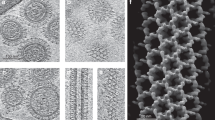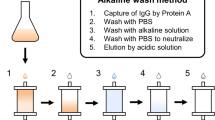Abstract
HISTOCOMPATIBILITY antigens have been solubilised by various means1, especially proteolytic digestion2–4, sonication5 and extraction with 3 M KCl6 or detergents7–8. Although detergents seem to solubilise the intact antigens these preparations have, until recently, proved difficult to fractionate further, whereas the products of the other procedures have proved amenable to purification but probably represent fragments of the membrane-bound antigen. This interpretation is based on the following arguments. First, solubilisation with 3 M KCl seems to depend on the presence of cell sap and was markedly reduced by protease inhibitors9. Second, in contrast to the detergent-solubilised antigen10, the other procedures yield non-aggregated products which, in general, possess similar molecular weights within the range 35,000–55,00010–12. Third, mouse and human histocompatibility antigens obtained by papain digestion seem to be glycoproteins (3–8% carbohydrate), whereas the antigens solubilised from guinea pig and human tissues by sonication and 3 M KCl extraction have been reported to be non-glycosylated (less than 1 % carbohydrate)12. This dichotomy would be explicable if the latter procedures had caused degradation and the consequent separation of the carbohydrate from the molecule bearing the antigenic determinant.
This is a preview of subscription content, access via your institution
Access options
Subscribe to this journal
Receive 51 print issues and online access
$199.00 per year
only $3.90 per issue
Buy this article
- Purchase on Springer Link
- Instant access to full article PDF
Prices may be subject to local taxes which are calculated during checkout
Similar content being viewed by others
References
Transplantation Antigens (edit. by Kahan, G. D., and Reisfeld, R. A.) (Academic, New York, 1972).
Sanderson, A. R., Nature, 220, 192 (1969).
Shimada, A., and Nathenson, S. G., Biochemistry, 8, 4048 (1969).
Cresswell, P., Turner, M. J., and Strominger, J. L., Proc. natn. Acad. Sci., U.S.A., 70, 1603 (1973).
Kahan, G. D., and Reisfeld, R. A., Bact. Rev., 35, 59 (1971).
Reisfeld, R. A., Pellegrino, M. A., and Kahan, B. D., Science, N.Y., 172, 1134 (1971).
Schwartz, B. D., and Nathenson, S. G., J. Immun., 107, 1363 (1971).
Dautigny, A., Bernier, I., Colombani, J., and Jolles, P., Biochim. biophys. Acta, 298, 783 (1973).
Mann, D. L., Transplantation, 14, 398 (1972).
Schwartz, B. D., Kato, K., Cullen, S. E., and Nathenson, S. G., Biochemistry, 12, 2157 (1973).
Summerell, J. M., and Davies, D. A. L., Biochim. biophys. Acta, 207, 92 (1970).
Reisfeld, R. A., and Kahan, B. D., in Transplantation Antigens, 489 (edit. by Kahan, B. D., and Reisfeld, R. A.) (Academic, New York, 1972).
Bodmer, W. F., Tripp, M., and Bodmer, J., in Histocompatibility Testing 1967, 341 (edit. by Curtoni, E. S., Mattiuz, P. L., and Tosi, R. M.) (Munksgaard, Copenhagen, 1967).
Reif, A. E., Immunochemistry, 3, 267 (1966).
Ferrone, S., Cooper, N. R., Pellegrino, M. A., and Reisfeld, R. A., J. Immun., 107, 939 (1971).
Haughton, G., Transplantation, 4, 238 (1966).
Ozer, J. H., and Wallech, D. F. H., Transplantation, 5, 652 (1967).
Allan, D., and Crumpton, M. J., Biochem. J., 120, 133 (1970).
Wilson, L. A., and Amos, D. B., Tissue Antigens, 2, 105 (1972).
Bodmer, W. F., Manual of Tissue Typing Techniques, 24 (edit. by Ray, J. G., Hare, D. B., and Kayhoe, D. E.) (DHEW, Publication No. (NIH) 74–545 1973).
Hayman, M. J., and Crumpton, M. J., Biochim. biophys. Res. Commun., 47, 923 (1972).
Hayman, M. J., Skehel, J. J., and Crumpton, M. J., FEBS Lett., 29, 185 (1973).
Stein, M. D., Howard, I. K., and Sage, H. J., Archs. Biochem. Biophys., 146, 353 (1971).
Evans, W. H., and Gurd, J. W., Biochem. J., 133, 189 (1973).
Martin, R. G., and Ames, B. N., J. biol. Chem., 236, 1372 (1961).
Helenius, A., and Simons, K., J. biol. Chem., 247, 3656 (1972).
Brand, C. M., and Skehel, J. J., Nature new Biol., 238, 145 (1972).
Wrigley, N. G., Skehel, J. J., Charlwood, P. A., and Brand, C. M., Virology, 51, 525 (1973).
Allan, D., and Crumpton, M. J., Biochem. J., 123, 967 (1971).
Author information
Authors and Affiliations
Rights and permissions
About this article
Cite this article
SNARY, D., GOODFELLOW, P., HAYMAN, M. et al. Subcellular Separation and Molecular Nature of Human Histocompatibility Antigens (HL-A). Nature 247, 457–461 (1974). https://doi.org/10.1038/247457a0
Received:
Issue Date:
DOI: https://doi.org/10.1038/247457a0
This article is cited by
-
Noncytolytic extraction of cell surface antigens using butanol
Cancer and Metastasis Review (1985)
-
Immunochemical ANALYSIS OF GLYCOSYLATED AND nonglycosylated dla class I antigens
Immunogenetics (1984)
-
HLA antigen expression at the single cell level on a K562 × B cell hybrid: An analysis with monoclonal antibodies using bacterial binding assays
Somatic Cell Genetics (1982)
-
Expression of major histocompatibility antigens on human thymocytes studied using monoclonal antibodies
Immunogenetics (1980)
-
A small polypeptide different from β2-microglobin associated with a human cell surface antigen
Nature (1979)
Comments
By submitting a comment you agree to abide by our Terms and Community Guidelines. If you find something abusive or that does not comply with our terms or guidelines please flag it as inappropriate.



